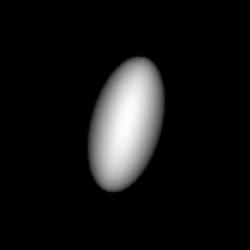 A small dwarf planet out past the orbit of Neptune could eventually become one of the brightest comets ever seen. Caltech professor Mike Brown – the discoverer of Eris – presented his calculations during the annual meeting of the American Astronomical Society held in Seattle in early January.
A small dwarf planet out past the orbit of Neptune could eventually become one of the brightest comets ever seen. Caltech professor Mike Brown – the discoverer of Eris – presented his calculations during the annual meeting of the American Astronomical Society held in Seattle in early January.
Until it gets a fancier name, the object is called 2003 EL61. It’s a rapidly spinning, football shaped object roughly the size of Pluto. Its elliptical orbit could eventually bring it close enough to Neptune that it would get a gravitational yank into the inner Solar System. It would change from a dwarf planet to a short period comet.
2003 EL61 spins rapidly, turning over and over like a badly thrown football. It completes a rotation once every 4 hours. What could give it such a strange shape and behaviour? Brown thinks it collided with another Kuiper belt object some time in its early history. The impact kicked it into fast spin, and elongated its shape. 2003 EL61 is even surrounded by a set of satellites, which could be the debris from this impact.
Don’t look to the skies just yet, though, 2003 EL61 might take millions of years before its interactions with Neptune shifts its orbit, and sends it into the inner Solar System.
Original Source: Mike Brown’s 2003 EL61 page.
